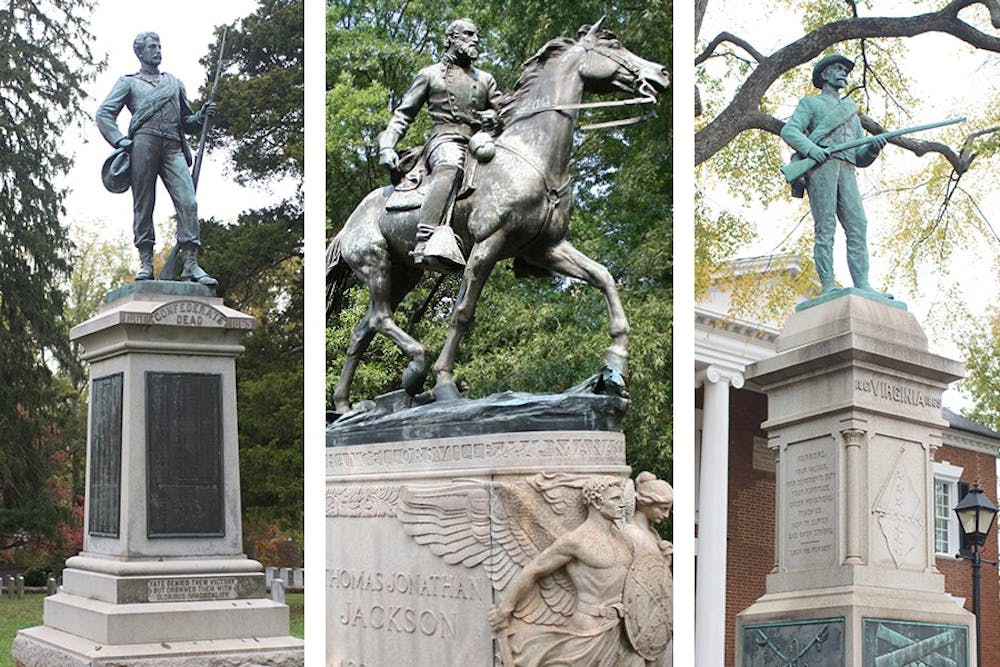The statue of Confederate General Robert E. Lee has been a controversial subject following the Charlottesville City Council’s February vote to remove it. City Council’s decision served as a rallying point for participants in the Aug. 11 and 12 white supremacist rallies. Though other Confederate statues in Charlottesville have a similar history, they have not received the same amount of attention — some say this is because they are not seen as widely recognized symbols of Confederate slave owners.
Paul McIntire, after whom the McIntire Commerce School is named, played an instrumental role in the construction of both prominent statues of Confederate leaders in downtown Charlottesville — one being Lee, the other a statue of Thomas “Stonewall” Jackson. He purchased the land in the late 1910s, which would become Lee Park and Jackson Park and are now named Emancipation Park and Justice Park, respectively.
The Lee statue was placed in Emancipation Park in May 1924 due to a prolonged construction process. Mary Walker Lee, Lee’s great-granddaughter, unveiled the statue and then-University President Edwin A. Alderman accepted the statue on behalf of the city.
The Jackson statue was presented in Justice Park, formerly named Jackson Park by Anna Jackson Preston, the great-great-granddaughter of General Stonewall Jackson. The unveiling was celebrated with a parade of around 5,000 attendees.
Patrick Saylor, marketing and communications director at the American Civil War Museum, a multi-site museum located in Richmond and Appomattox, said the Lee statue was a natural focal point of the debate since Robert E. Lee is a popular and widely-recognized Confederate figure and that many revered Lee for his personal qualities.
“Of Confederate generals memorialized via the Lost Cause, Lee was elevated as the most virtuous, even above Jefferson Davis and Stonewall Jackson,” Saylor said. “Therefore, Lee is the most widely memorialized Confederate, with more than 26 statues, markers and countless other designations.”
Nathan John, a third-year Batten student and a Black Student Alliance political action advisor, said that others focus on what Lee represented to the South at the time.
“Throughout the South, [Lee] has been lionized as a war hero, faithful Virginian, and a morally upright man who simply fought for freedom of the beloved State of his birth,” John said in an email to The Cavalier Daily.
Douglas Blackmon, the director of public programs and executive producer of “American Forum” for the Miller Center, also pointed out that City Council has likely only focused on statues within their jurisdiction, even if others are close to Charlottesville and accessible to its residents.
“I assume it’s also because the Charlottesville discussion began with the City Council, and the Lee and Jackson statues are on city property — unlike the monument a short distance up the street in front of the Albemarle County courthouse,” Blackmon said in an email to The Cavalier Daily.
The monument Blackmon refers to is located outside of the Albemarle County Circuit Court courthouse and depicts an unnamed Confederate soldier with a carved Confederate flag.
“The flag that for the past century has been the symbol of the Ku Klux Klan, white supremacy, neo-nazis and massive resistance to civil rights and integrated public schools is ‘flying’ day and night in front of the courthouse — a place that citizens are frequently compelled by their government to visit,” Blackmon said.
The statue also has an inscription which says the monument exists to teach viewers the lessons of the Confederate experience.
“It is, arguably, much more offensive than either of the Robert E. Lee or Stonewall Jackson monuments,” Blackmon said. “At least those statues don’t have inscriptions explicitly endorsing slavery or applauding a treasonous, white-southern revolt intent on destroying the United States and preserving the enslavement of millions of Americans.”
Blackmon said that both the timing and the location of the statue — across the street from where slaves were sold and erected in 1909 when legislation protecting civil rights had not yet been implemented — were intentional.
“That is the real message of that monument — that only people who agree with its messages are welcome in the center of governmental and commercial activity,” Blackmon said. “Every time a county worker goes out to blow away the leaves at its base, or clean up a piece of trash, our community is spending tax dollars to restate the offensive, cruel message of the monument.”
According to John, the special significance placed on Lee is a result of his strong embodiment of the Confederate cause.
“As opposed to Stonewall Jackson, whose notoriety arose from the fact that he died valiantly in battle, Lee was never killed by Northern troops,” John said. “Rather, he survived the war and surrendered gracefully, even going on to serve in government after the war. Thus, to many, General Lee embodies the indomitable nature of the South and the Confederate way of living.”
City Council also voted to remove the statue of Jackson Sept. 5. The Council decided to not remove the Jackson statue when it voted in February to take down the one of Lee. The decision to remove the Jackson statue was motivated by the Aug. 12 “Unite the Right” rally, which occurred less than a month prior to the vote. The city has been unable to remove either statue due to pending litigation and has since covered both of them with black shrouds.
“In the end, many of those today who advocate so vociferously against the removal of the [Lee] statue cannot bear to see the pinnacle of Southern pride removed from its mythic peak,” John said. “Ultimately, we must all contend with the racist history behind why such statues were even erected in the first place, to better understand why their removal is so long overdue.”







